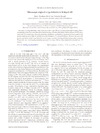Please use this identifier to cite or link to this item:
https://accedacris.ulpgc.es/jspui/handle/10553/75664
| DC Field | Value | Language |
|---|---|---|
| dc.contributor.author | Fernández Hevia, Daniel | en_US |
| dc.contributor.author | Stampfl, Catherine | en_US |
| dc.contributor.author | Viñes, Francesc | en_US |
| dc.contributor.author | Illas, Francesc | en_US |
| dc.date.accessioned | 2020-11-18T09:28:50Z | - |
| dc.date.available | 2020-11-18T09:28:50Z | - |
| dc.date.issued | 2013 | en_US |
| dc.identifier.issn | 1098-0121 | en_US |
| dc.identifier.other | WoS | - |
| dc.identifier.uri | https://accedacris.ulpgc.es/handle/10553/75664 | - |
| dc.description.abstract | In contrast to a long held belief, it has been shown that n-type AlN can be achieved through Si-doping. This is unexplainable from the current theoretical understanding, a situation that hinders further progress in AlN-based ultraviolet (UV) technologies. From first-principles calculations, we find that n-type behavior arises under N-rich growth conditions due to high Si solubility and to the formation of V Al-bound Si clusters. We show that metal-rich growth may lead to weak n-type behavior due to oxygen impurities binding and deactivating cation vacancies. We provide clues for designing production processes for n-type AlN as a base material for potential new UV sources. | en_US |
| dc.language | eng | en_US |
| dc.relation | Efesot-Eficiencia Energética en Protección Contra Sobretensiones | en_US |
| dc.relation | Cascada-Cambiador de Tomas en Carga Para Redes de Distribución Activa de Energía Eléctrica. | en_US |
| dc.relation.ispartof | Physical Review B - Condensed Matter and Materials Physics | en_US |
| dc.source | Physical Review B [ISSN 1098-0121], v. 88 (8), 085202, (Agosto 2013) | en_US |
| dc.subject | 3303 ingeniería y tecnología químicas | en_US |
| dc.subject.other | Molecular-Beam Epitaxy | en_US |
| dc.subject.other | Conduction | en_US |
| dc.subject.other | Alxga1-Xn | en_US |
| dc.subject.other | Donor | en_US |
| dc.subject.other | Gan | en_US |
| dc.subject.other | Impurities | en_US |
| dc.subject.other | Nitrides | en_US |
| dc.subject.other | Defects | en_US |
| dc.title | Microscopic origin of n-type behavior in Si-doped AlN | en_US |
| dc.type | info:eu-repo/semantics/Article | en_US |
| dc.type | Article | en_US |
| dc.identifier.doi | 10.1103/PhysRevB.88.085202 | en_US |
| dc.identifier.isi | 000322913200004 | - |
| dc.identifier.eissn | 1550-235X | - |
| dc.identifier.issue | 8 | - |
| dc.relation.volume | 88 | en_US |
| dc.investigacion | Ciencias | en_US |
| dc.type2 | Artículo | en_US |
| dc.contributor.daisngid | 3261521 | - |
| dc.contributor.daisngid | 153051 | - |
| dc.contributor.daisngid | 393276 | - |
| dc.contributor.daisngid | 14679 | - |
| dc.description.numberofpages | 6 | en_US |
| dc.utils.revision | Sí | en_US |
| dc.contributor.wosstandard | WOS:Hevia, DF | - |
| dc.contributor.wosstandard | WOS:Stampfl, C | - |
| dc.contributor.wosstandard | WOS:Vines, F | - |
| dc.contributor.wosstandard | WOS:Illas, F | - |
| dc.date.coverdate | Agosto 2013 | en_US |
| dc.identifier.ulpgc | Sí | en_US |
| dc.description.sjr | 2,804 | |
| dc.description.jcr | 3,664 | |
| dc.description.sjrq | Q1 | |
| dc.description.jcrq | Q1 | |
| item.grantfulltext | open | - |
| item.fulltext | Con texto completo | - |
| crisitem.project.principalinvestigator | Pérez Peña, Jesús | - |
| crisitem.project.principalinvestigator | Pérez Peña, Jesús | - |
| Appears in Collections: | Artículos | |
WEB OF SCIENCETM
Citations
22
checked on Jun 8, 2025
Page view(s)
92
checked on Dec 14, 2024
Download(s)
186
checked on Dec 14, 2024
Google ScholarTM
Check
Altmetric
Share
Export metadata
Items in accedaCRIS are protected by copyright, with all rights reserved, unless otherwise indicated.
